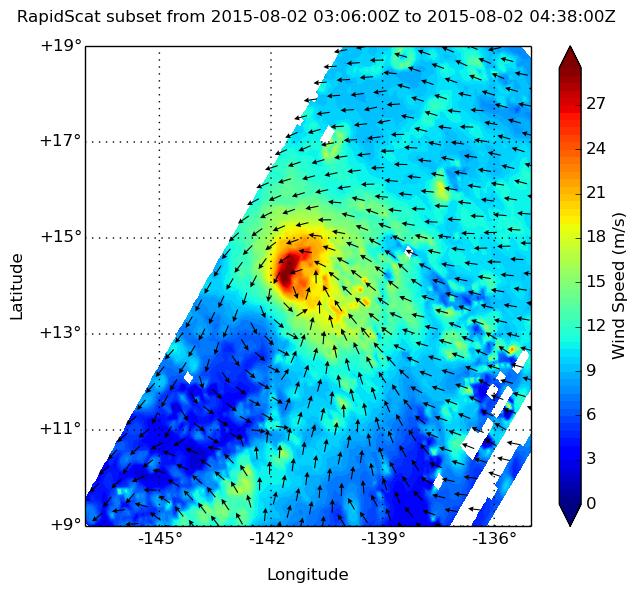NASA's RapidScat sees Hurricane Guillermo's strongest winds on western side

RapidScat gathered data on Guillermo on Sunday, Aug. 2, 2015, at 12 a.m. EDT and saw strongest winds near 30 meters per second (67 mph/108 kph) on the western side of the storm. Credits: NASA JPL, Doug Tyler
As Hurricane Guillermo continued moving toward the Hawaiian Islands, NASA's RapidScat instrument that flies aboard the International Space Station analyzed its surface winds. RapidScat found the strongest winds were on the western side of the storm facing the Hawaiian Islands and helping generate rough surf along eastern-facing shores.
RapidScat gathered data on Guillermo on Sunday, Aug. 2, 2015, at 4 p.m. UTC (12 a.m. EDT). At that time the strongest winds were measured near 30 meters per second (67 mph/108 kph) on the western side of the storm. On Aug. 3, hurricane force winds extended outward up to 35 miles (55 km) from the center and tropical storm force winds extend outward up to 130 miles (215 km).
Guillermo continues to kick up rough surf along east facing shores of the Hawaiian Islands.
At 5 a.m. EDT (0900 UTC) on Aug. 3, the center of Hurricane Guillermo was located near latitude 16.2 north…longitude 145.4 west. That puts Guillermo's center about 680 miles (1,095 km) east-southeast of Hilo, Hawaii, and 890 miles (1,430 km) east-southeast of Honolulu. Maximum sustained winds are near 75 mph (120 kph) and the National Hurricane Center expects the storm to steadily weaken over the next couple of days.
Guillermo was moving toward the west-northwest near 10 mph (17 kph) and this motion is expected to continue over the next couple of days with a slight shift toward the west. The estimated minimum central pressure is 990 millibars.
At 1200 UTC (8 a.m. EDT), Aug. 3, NOAA's GOES-West satellite captured an infrared image of Guillermo. Guillermo appeared somewhat elongated in the image, and there was no eye visible.
Guillermo is continuing to move west-northwest and is expected to continue weakening as it runs into increasingly unfavorable atmospheric conditions. The Central Pacific Hurricane Center noted that Guillermo is expected to move near or possibly over the Hawaiian islands on Wednesday, Aug. 5 and Thursday, Aug. 6. For daily forecasts, visit: http://www.
Media Contact
All latest news from the category: Earth Sciences
Earth Sciences (also referred to as Geosciences), which deals with basic issues surrounding our planet, plays a vital role in the area of energy and raw materials supply.
Earth Sciences comprises subjects such as geology, geography, geological informatics, paleontology, mineralogy, petrography, crystallography, geophysics, geodesy, glaciology, cartography, photogrammetry, meteorology and seismology, early-warning systems, earthquake research and polar research.
Newest articles

“Nanostitches” enable lighter and tougher composite materials
In research that may lead to next-generation airplanes and spacecraft, MIT engineers used carbon nanotubes to prevent cracking in multilayered composites. To save on fuel and reduce aircraft emissions, engineers…

Trash to treasure
Researchers turn metal waste into catalyst for hydrogen. Scientists have found a way to transform metal waste into a highly efficient catalyst to make hydrogen from water, a discovery that…

Real-time detection of infectious disease viruses
… by searching for molecular fingerprinting. A research team consisting of Professor Kyoung-Duck Park and Taeyoung Moon and Huitae Joo, PhD candidates, from the Department of Physics at Pohang University…




















